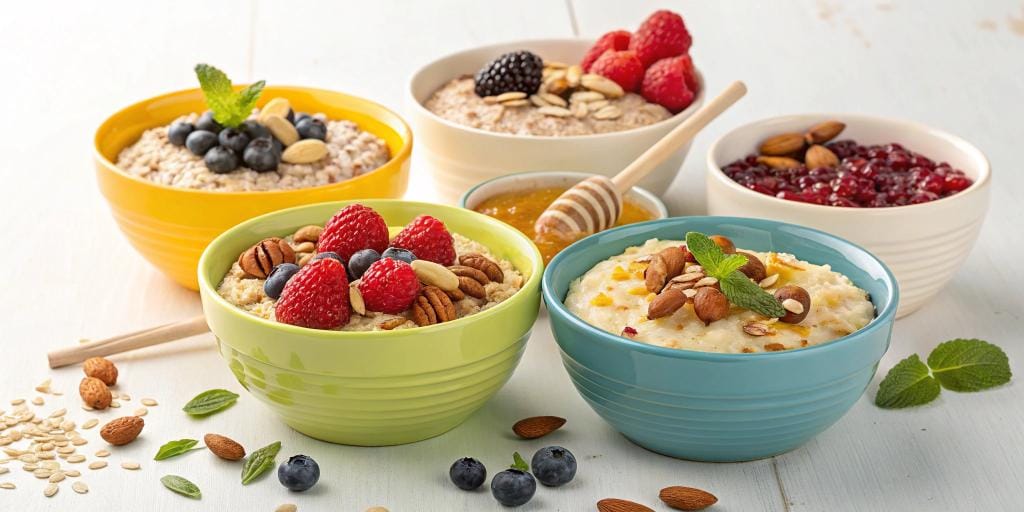Introduction:
Picture the cozy warmth of a bowl of oatmeal on a brisk morning, its creamy texture enveloping your taste buds, and a hint of sweetness tantalizing your senses. Or envision the satisfying chew of steel-cut oats, hearty and robust, providing the perfect kickstart to an invigorating day. Oatmeal, often seen as a basic breakfast option, is a gateway to a vast array of culinary delights.
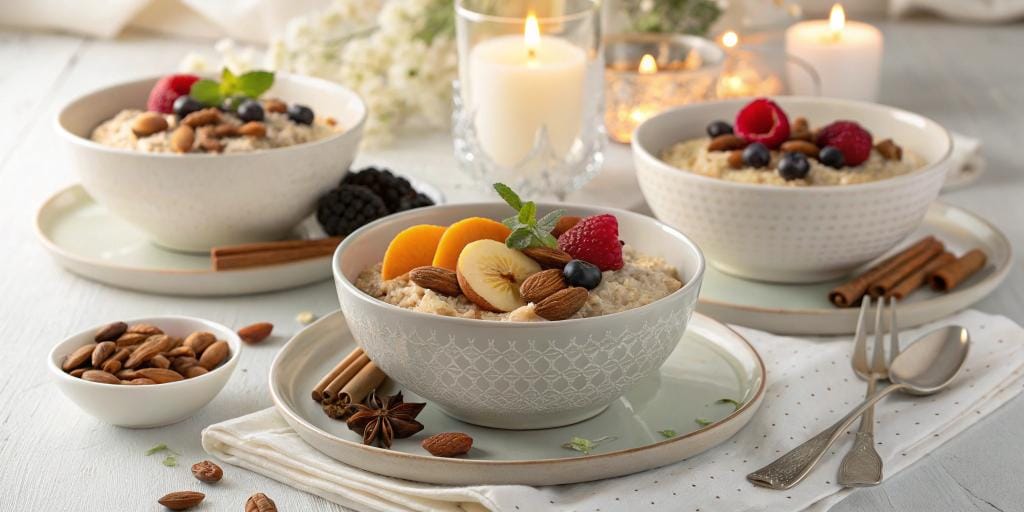
This journey is not merely about cooking oats in boiling water; it’s about discovering a rich tapestry of flavors and health benefits through a variety of delightful recipes. This article takes you through the captivating world of oatmeal recipes, from traditional favorites to creative innovations, revealing the secrets to crafting the ideal bowls of oat-based goodness that cater to every palate and dietary requirement. Get ready to embark on a flavorful adventure filled with inspiration and practical tips to elevate your morning routine.
Key Features of Oatmeal Recipes:
Oatmeal is anything but boring; it is incredibly versatile. The humble oat, available in various forms—rolled oats, steel-cut oats, quick-cooking oats—serves as a blank canvas for culinary imagination. This versatility is a significant reason for the popularity of oatmeal recipes. Breakfast cereals, including oatmeal, make up a substantial part of the breakfast market worldwide, underscoring the lasting appeal of this nutritious grain. Growing awareness of the health benefits of whole grains continues to drive this trend, with many people turning to oatmeal for its fiber content, which supports digestion and helps maintain a feeling of fullness.
The essential qualities that make oatmeal recipes so appealing are their simplicity, versatility, and nutritional value. The fundamental recipe—oats combined with liquid—requires minimal ingredients but allows for endless variations. Sweet recipes can incorporate fruits, nuts, seeds, and sweeteners, creating a delightful mix of textures and flavors. Imagine the burst of fresh berries mingling with crunchy nuts, or the gentle sweetness of maple syrup harmonizing with the warm notes of cinnamon. Conversely, savory recipes can surprise with ingredients like mushrooms, spinach, and herbs, resulting in a sophisticated and satisfying meal. The options are truly limitless.
Additionally, oatmeal can be easily customized to meet various dietary needs. Vegan recipes are plentiful, utilizing plant-based milk and sweeteners. Gluten-free options can be made by incorporating certified gluten-free oats, catering to those with sensitivities. Recipes can also be tailored to specific dietary goals, with some focusing on protein for muscle development and others emphasizing fiber for digestive health. Oatmeal’s ability to adapt makes it a cornerstone of healthy eating. The wide range of recipes available, from quick microwave meals to slow-cooked overnight oats, suits every lifestyle and schedule. Whether you are a busy professional or a leisurely weekend cook, there’s an oatmeal recipe just for you.
Essential Ingredients for Oatmeal Recipes
The charm of oatmeal lies in its adaptability. A simple bowl can be transformed into a culinary delight with just a few additions. While the base remains consistently humble—oats—the possibilities are as expansive as the sky at dawn. Here are the key ingredients, organized for easy reference:
The Oatmeal Base:
Oats: Choose your preferred type! Rolled oats cook quickly, steel-cut oats provide a chewy texture, and quick-cooking oats are ideal for busy mornings. One cup of dry oats typically serves one person.
Liquid Love:
Water or Milk: Water offers a classic, clean taste. Milk—whether dairy or plant-based (almond, soy, oat)—adds creaminess and richness. Use about 1 to 1.5 cups of liquid per cup of oats.
Sweeteners (Optional, but delightful):
Honey, Maple Syrup, or Agave Nectar: These natural sweeteners lend a touch of sweetness and complexity to your oatmeal. One to two tablespoons are usually sufficient.
Brown Sugar or White Sugar: Classic sweeteners for a familiar flavor.
Flavor Enhancers (The fun part!):
Fruits: Fresh or frozen berries, bananas, sliced apples—the options are endless! Their vibrant colors and juicy textures add a delightful burst to your breakfast.
Nuts and Seeds: Almonds, walnuts, pecans, chia seeds, flax seeds—these provide healthy fats, crunch, and a nutty aroma that awakens the senses.
Spices: A sprinkle of cinnamon, nutmeg, or cardamom can elevate your oatmeal to an aromatic delight.
Chocolate Chips: A beloved addition for a sweet treat.
This list serves as an excellent starting point. Remember, the magic of oatmeal recipes lies in your personal touch and willingness to experiment.
Step-by-Step Guide to Making Oatmeal Recipes
Making oatmeal is a straightforward process, easily mastered by anyone, even children! However, the journey from simple grains to a delicious breakfast bowl is where the real enchantment occurs. Let’s embark on this culinary adventure together:
Step 1: The Foundation – Measuring the Oats:
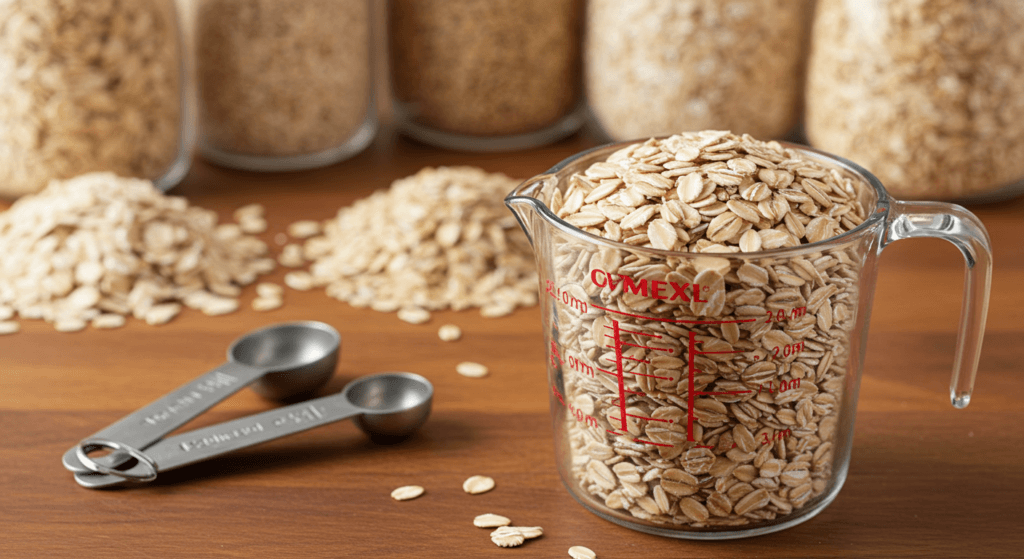
Begin by measuring your desired amount of oats. Start with one cup of dry oats for a single serving, adjusting as needed. If you’re using quick-cooking oats, you can use slightly less liquid; steel-cut oats, being denser, will require a bit more.
Step 2: The Liquid Infusion – Adding Water or Milk:
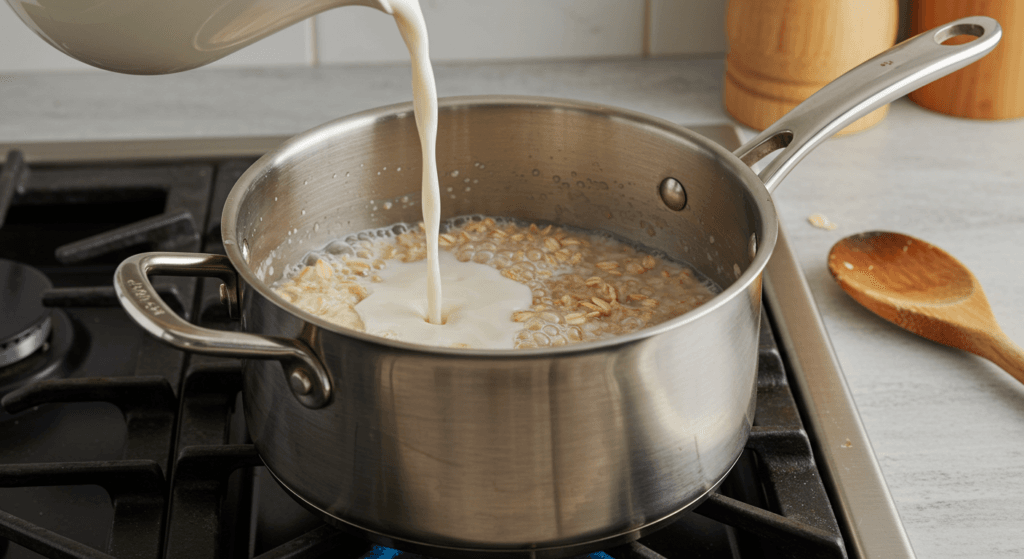
Next, pour in your chosen liquid—water or milk. For one cup of oats, start with 1 to 1.5 cups of liquid. You can always add more later if necessary. The gentle bubbling as the water meets the oats is the first sign of the transformation to come.
Step 3: The Simmer – Cooking the Oats:
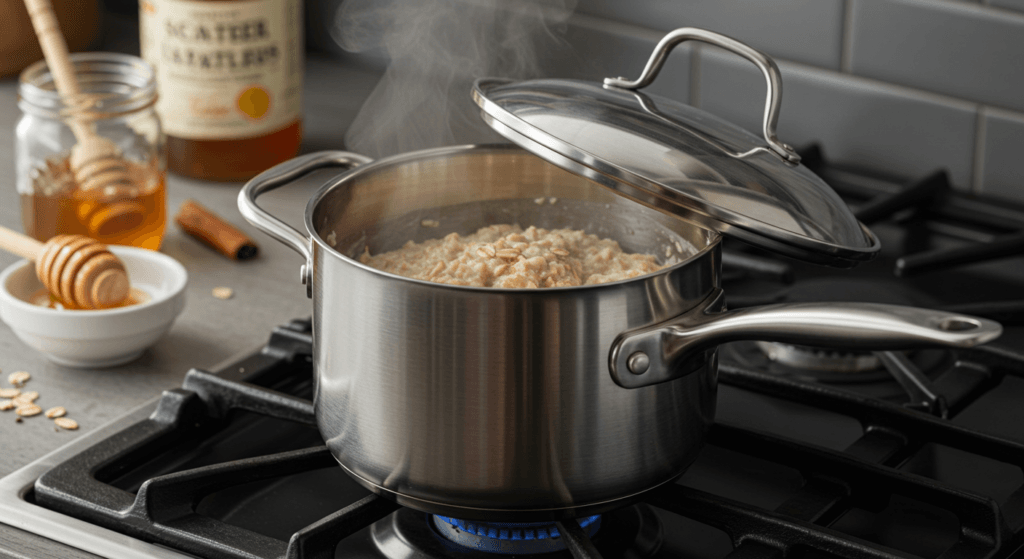
Bring the mixture to a boil in a saucepan over medium heat, stirring occasionally to prevent sticking. Once boiling, reduce the heat to low, cover, and let it simmer gently. Cooking times will vary based on the type of oats: quick-cooking oats take just a few minutes, while steel-cut oats may need 20-30 minutes for a perfectly creamy texture. The aroma filling your kitchen is a warm and comforting symphony.
Step 4: The Sweetening – Adding Flavor:
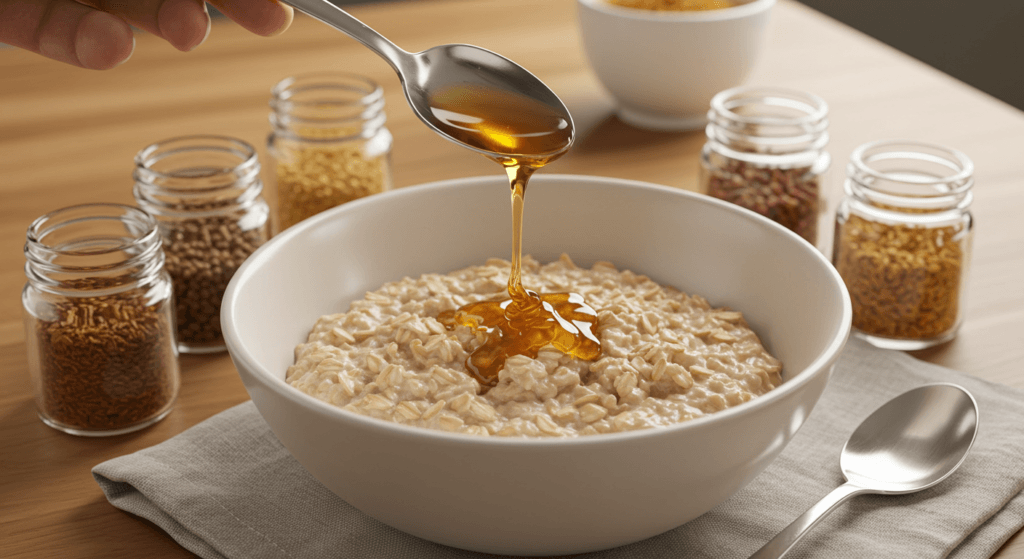
Once the oats are cooked to your liking, remove the saucepan from the heat. Stir in your chosen sweetener—honey, maple syrup, or sugar—according to taste. The sweetness should enhance, not overpower, the natural flavor of the oats.
Step 5: The Garnish – Adding Toppings:
Now comes the fun part! Add your favorite toppings—fresh or frozen fruits, nuts, seeds, spices, or chocolate chips. Let your creativity shine! The vibrant colors of the berries, the crunch of the nuts, the warmth of the spices—it’s a sensory experience that awakens your taste buds.
Step 6: The Finale – Enjoying Your Creation:
Finally, pour your deliciously garnished oatmeal into a bowl. Take a moment to appreciate the transformation from simple ingredients to a comforting, flavorful breakfast. Each spoonful is a small moment of joy, a celebration of simple pleasures.
Tips for Oatmeal Perfection:
Salt: A pinch of salt enhances the flavor of your oatmeal.
Experiment: Don’t hesitate to try new flavor combinations.
Texture: Adjust the cooking time to achieve your desired texture.
Leftovers: Store leftover oatmeal in an airtight container in the refrigerator for up to three days.
These straightforward steps, combined with a sprinkle of creativity, will turn your oatmeal recipes into a daily delight. Enjoy!
Nutritional Value of Oatmeal Recipe Ingredients
Ingredient Nutritional Value Health Benefits
Oats (Rolled/Steel-Cut) High in fiber, complex carbohydrates, protein, and various vitamins and minerals. Promotes digestive health, regulates blood sugar, provides sustained energy, supports heart health, and aids weight management.
Fruits (Berries, Banana) Rich in antioxidants, vitamins, and fiber. Boosts immunity, protects against cell damage, improves gut health, and contributes to overall well-being.Nuts & Seeds (Almonds, Chia Seeds) Excellent source of healthy fats, protein, fiber, and micronutrients. Supports brain function, improves heart health, reduces inflammation, and provides essential fatty acids.Spices (Cinnamon, Nutmeg) Contain antioxidants and may offer anti-inflammatory benefits. May improve blood sugar control, reduce risk of chronic diseases, and enhance the flavor of oatmeal recipes.
Benefits of Oatmeal Recipes
Oatmeal, a culinary chameleon, offers a wealth of benefits. Imagine starting your day with a warm bowl, its comforting aroma a gentle wake-up call. This is more than just breakfast; it’s a nourishing ritual, a daily boost of well-being. The fiber content acts like a tiny broom, sweeping away cholesterol and stabilizing blood sugar levels, preventing those mid-morning energy crashes.
For athletes, oatmeal is a powerhouse, providing sustained energy for intense workouts. Think of it as fuel for your body’s engine, ensuring optimal performance. For those watching their weight, its high fiber content promotes a feeling of fullness, helping to curb unhealthy cravings. My own experience confirms this: after incorporating oatmeal into my daily breakfast, I noticed a significant boost in my energy levels and a gradual decrease in weight. Oatmeal isn’t just food; it’s a lifestyle choice, a commitment to a healthier, more vibrant you. Its versatility allows for endless creative recipes, transforming a simple bowl into a culinary masterpiece.
Overcoming Challenges with Oatmeal Recipes
Many people find oatmeal a bit… bland. Fear not! Transform that plain bowl into a flavor explosion. Experiment with spices—a dash of cinnamon or nutmeg can make a world of difference. Embrace the vibrant colors and flavors of fresh fruit—berries, bananas, mangoes—each adding its unique touch. Nuts and seeds provide a delightful crunch and enhance the nutritional profile.

Don’t hesitate to get creative! Add a dollop of yogurt or a drizzle of honey for extra richness. If your oatmeal is too thick, simply add a splash of milk or water. If it’s too watery, cook it a little longer. The key is experimentation; find what tastes best to you. Remember, even a simple bowl of oatmeal can be a culinary adventure.
Future Trends in Oatmeal Recipes
The oatmeal landscape is evolving. We’re witnessing a rise in interest in unique flavor combinations, moving beyond traditional options. Savory oatmeal, once a niche idea, is gaining traction, showcasing unexpected ingredient pairings. Plant-based options, such as vegan and gluten-free recipes, are flourishing, reflecting a growing consumer demand for healthier and inclusive food choices. Convenience is also a major factor; pre-packaged, ready-to-eat oatmeal cups are becoming increasingly popular. Technological advancements, like personalized nutrition apps, may further tailor oatmeal recipes to individual preferences. The future of oatmeal is bright, promising a diverse array of options to satisfy every palate and lifestyle.
Tips and Tricks for Oatmeal Recipes
For perfectly cooked oatmeal, use the right ratio of oats to liquid. Experiment with different types of oats—steel-cut for a hearty texture, rolled oats for a quicker cook. Avoid overcooking; slightly undercooked oats maintain a better texture. Enhance flavor with a pinch of salt, a squeeze of lemon, or a splash of vanilla extract. To add a touch of luxury, top your oatmeal with toasted nuts, seeds, or dried fruits. Consider using milk alternatives like almond or soy milk for a different flavor profile. A drizzle of maple syrup or a dollop of nut butter adds sweetness and healthy fats. Remember, the possibilities are endless!
Variations and Adaptations of Oatmeal Recipes
Oatmeal is incredibly adaptable. For a gluten-free option, ensure your oats are certified gluten-free. Vegetarian and vegan recipes can easily be created by omitting dairy and using plant-based milk alternatives. For those with nut allergies, sunflower or pumpkin seeds can serve as substitutes. Consider adding protein powder for a post-workout boost or chia seeds for added fiber and omega-3 fatty acids. Sweeten naturally with fruit or maple syrup instead of refined sugar. The beauty of oatmeal lies in its ability to accommodate diverse dietary needs and preferences, making it a truly inclusive breakfast option.
FAQs about Oatmeal Recipes
Q: Can I use different types of milk?
A: Absolutely! Almond, soy, oat, and coconut milk all work wonderfully.
Q: How long can I store cooked oatmeal?
A: Cooked oatmeal is best enjoyed fresh, but leftovers can be stored in the refrigerator for up to three days.
Q: Can I make oatmeal ahead of time?
A: Yes, overnight oats are a popular and convenient option.
Q: What are some creative topping ideas?
A: Try adding fresh or frozen fruit, nuts, seeds, spices, chocolate chips, or even a dollop of yogurt.
Conclusion
From its nutritional powerhouse status to its remarkable versatility, oatmeal has secured its place as a breakfast staple. We’ve explored its health benefits, tackled common cooking challenges, and glimpsed its exciting future trends. Remember, the best oatmeal recipes are the ones you create and enjoy. So, experiment, innovate, and share your culinary creations with us in the comments below! Don’t forget to subscribe for more delicious and healthy recipes. Let’s continue this culinary journey together!

